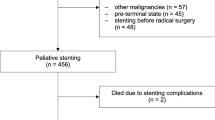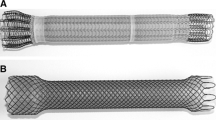Abstract
Background
Self-expandable metal stents placed across the esophagogastric junction for palliative treatment of malignant strictures may lead to gastroesophageal reflux and pulmonary aspiration. This study compared the effects of a Dua antireflux stent with those of a conventional stent.
Methods
Patients with incurable cancer of the distal esophagus or gastric cardia were randomly assigned to receive an antireflux stent (n = 19) or a standard stent (n = 22) at nine Swedish hospitals during the period September 1, 2003 to July 31, 2005. Complications were recorded at clinical follow-up visits. Survival rates were assessed through linkage to the Population Register. Dysphagia, reflux symptoms, esophageal pain, dyspnea, and global quality of life were assessed as changes in mean scores between baseline and 1 month after stent insertion through validated questionnaires.
Results
No technical problems occurred during stent placement in the 41 enrolled patients. Fewer patients with complications were observed in the antireflux stent group (n = 3) than in the standard group (n = 8), but no statistically significant difference was shown (p = 0.14). The survival rates were similar in the two groups (p = 0.99; hazard ratio, 1.0; 95% confidence interval, 0.5–2.0). The groups did not differ significantly in terms of studied esophageal or respiratory symptoms or quality of life. Clinically relevant improvement in dysphagia occurred in both groups. Dyspnea decreased after antireflux stent insertion (mean score change, –11), and increased after insertion of standard stent (mean score change, +21).
Conclusions
Antireflux stents may be used without increased risk of complications, mortality, esophageal symptoms, or reduced global quality of life. These results should encourage large-scale randomized trials that can establish potentially beneficial effects of antireflux stents.


Similar content being viewed by others
References
Aaronson NK, Ahmedzai S, Bergman B, Bullinger M, Cull A, Duez NJ, Filiberti A, Flechtner H, Fleishman SB, de Haes JC, Kaasa S, Klee M, Osoba D, Razavi D, Rofe PB, Schraub S, Sneeuw K, Sullivan M, Takeda F (1993) The European Organization for Research and Treatment of Cancer QLQ-C30: a quality-of-life instrument for use in international clinical trials in oncology. J Natl Cancer Inst 85: 365–376
Blazeby JM, Alderson D, Winstone K, Steyn R, Hammerlid E, Arraras J, Farndon JR (1996) Development of an EORTC questionnaire module to be used in quality-of-life assessment for patients with oesophageal cancer. The EORTC Quality of Life Study Group. Eur J Cancer 32A: 1912–1917
Dua KS, Kozarek R, Kim J, Evans J, Medda BK, Lang I, Hogan WJ, Shaker R (2001) Self-expanding metal esophageal stent with anti-reflux mechanism. Gastrointest Endosc 53: 603–613
Fayers P, Aaronson N, Bjurdal K, Sullivan M, Curran D, Groenvold M (1999) The EORTC QLQ-C 30 Scoring Manual. European Organisation for Research and Treatment of Cancer, Brussels, Belgium
Homs MY, Wahab PJ, Kuipers EJ, Steyerberg EW, Grool TA, Haringsma J, Siersema PD (2004) Esophageal stents with antireflux valve for tumors of the distal esophagus and gastric cardia: a randomized trial. Gastrointest Endosc 60: 695–702
King MT (1996) The interpretation of scores from the EORTC quality-of-life questionnaire QLQ-C30. Qual Life Res 5: 555–567
Knyrim K, Wagner HJ, Bethge N, Keymling M, Vakil N (1993) A controlled trial of an expansile metal stent for palliation of esophageal obstruction due to inoperable cancer. N Engl J Med 329: 1302–1307
Laasch HU, Marriott A, Wilbraham L, Tunnah S, England RE, Martin DF (2002) Effectiveness of open versus antireflux stents for palliation of distal esophageal carcinoma and prevention of symptomatic gastroesophageal reflux. Radiology 225: 359–365
Nunes CC, Waechter FL, Sampaio JA, Pinto RD, Aluares- Da-Silva MR, Pereira-Lima L (1999) Comparative postoperative study of prostheses with an antireflux valve system in the palliative treatment of esophageal carcinoma. Hepatogastroenterology 46: 2859–2864
Osoba D, Rodrigues G, Myles J, Zee B, Pater J (1998) Interpreting the significance of changes in health-related quality-of-life scores. J Clin Oncol 16: 139–144
Shim CS, Jung IS, Cheon YK, Ryu CB, Hong SJ, Kim JO, Cho JY, Lee JS, Lee MS, Kim BS (2005) Management of malignant stricture of the esophagogastric junction with a newly designed self-expanding metal stent with an antireflux mechanism. Endoscopy 37: 335–339
Valbuena J (1984) Endoscopic palliative treatment of esophageal and cardial cancer: a new antireflux prosthesis: a study of 40 cases. Cancer 53: 993–998
Wenger U, Luo J, Lundell L, Lagergren J (2005) A nationwide study of the use of self-expanding stents in patients with esophageal cancer in Sweden. Endoscopy 37: 329–334
Wu WC, Katon RM, Saxon RR, Barton RE, Uchida BT, Keller FS, Rosch J (1994) Silicone-covered self-expanding metallic stents for the palliation of malignant esophageal obstruction and esophagorespiratory fistulas: experience in 32 patients and a review of the literature. Gastrointest Endosc 40: 22–33
Acknowledgments
We express our gratitude to Eja Fridsta for study coordination, and to contact doctors not included among the authors, namely, John Blomberg, Stefan Linder, Angelica Pannes, Dag Stockeld, Ervin Toth, and Sören Vallgren. Funding was provided by the Swedish Cancer Society, the Swedish Cancer and Traffic Injury Fund, and Wilson-Cooks Medicals.
Author information
Authors and Affiliations
Corresponding author
Rights and permissions
About this article
Cite this article
Wenger, U., Johnsson, E., Arnelo, U. et al. An antireflux stent versus conventional stents for palliation of distal esophageal or cardia cancer: a randomized clinical study. Surg Endosc 20, 1675–1680 (2006). https://doi.org/10.1007/s00464-006-0088-2
Received:
Accepted:
Published:
Issue Date:
DOI: https://doi.org/10.1007/s00464-006-0088-2




